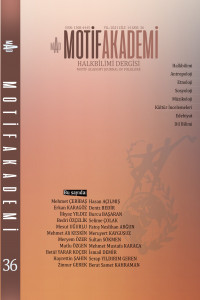MASALLARDA BİTİŞ FORMELLERİ: İDİL URAL (TATAR) MASALLARI ÖRNEĞİ
CLOSING FORMULAE IN TALES: THE CASE OF IDEL-URAL (TATAR) TALES
Author(s): Erkan KaragözSubject(s): Customs / Folklore, Studies of Literature, Turkish Literature, Cultural Anthropology / Ethnology
Published by: Motif Halk Oyunları Eğitim ve Öğretim Vakfı
Keywords: Tale; closing formula; end of tale rhyme; Tatar; Idel-Ural;
Summary/Abstract: Closing formulas, a type of formula, which is one of the building blocks of tales, are told by storytellers to conclude a tale and they draw attention with their different uses. In this study, the closing formulas in the tales of Tatar Turks, one of the ancient peoples of the Idel-Ural Region, which has a rich storytelling tradition, have been examined from various aspects and classified. In the resulting classification, the closing formulas have been collected under four main titles, plain, abrupt, personal, and instructive, which are examined under separate headings in the study. Of these main titles, only plain closing formulas have been classified under seven titles due to their versatile use, as those related to finding salvation, returning home, holding a wedding, having a feast, gaining power, giving punishment, and forgiving. For the classification of formulas, considering that possible closing formulas may be added later, the alphabetical numbering method that Thompson systematized in his Motif Index of Folk Literature was combined with the technique of naming the items Sakaoğlu used in his work “Tale Studies” while classifying formulas, and a new system of classification has been developed. This classification was first used in the study “The Opening Formula in Tales: The Case of IdelUral (Tatar and Bashkir) Tales,” in which the applicability of the formula for the tales of the Turkic world was tested and explained through opening formulas. The closing formulas, which were included only as a main heading and left undetailed, has been examined in this study. As a result of the study, various usage and form features of the closing formulas classified in the four main headings in the case of Tatar tales have been revealed, and a contribution has been made to the research on tale formulas.
Journal: Motif Akademi Halkbilimi Dergisi
- Issue Year: 14/2021
- Issue No: 36
- Page Range: 1207-1226
- Page Count: 20
- Language: Turkish

